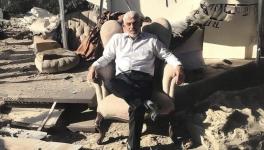No Exit from Gaza: A New War Crime?
(Prefatory Note: this is a modified version of a post published online, July 15, 2014, at the recently established very informative website, Middle East Eye; as the casualty totals continue to mount while the world looks on in stupefied inaction, the attacks go on; at the very least, from a humanitarian perspective,there should be a global outcry demanding that children, mothers, and those sick and disabled be allowed to leave the Gaza Strip until current hostilities end. Yet this is a gap in international humanitarian law, refugee law, and the moral sensibilities of the combatant states.)
As the hideous Israeli assault on Gaza, named Operation Protective Edge, by the IDF enters its second week, overdue international appeals for a ceasefire fall on deaf ears. The short lived July 15th ceasefire arranged by Sisi’s Egypt had many accompanying signs of bad faith from its inception, including the failure to allow Hamas to participate in the process, insultingly conveying the proposed terms of the ceasefire through public media. The vague terms depicted, alongside the failure to take any account of Hamas’ previously announced conditions, suggest that this initiative was not a serious effort to end the violence, but rather a clever ploy to regain moral credibility for Israel thereby facilitating the continuation and even intensification of its violent military campaign that was never defensive in conception or execution. Rather than being a real effort to end the violence, such a ‘ceasefire’ seems best understood as a sophisticated for form of escalation produced by a descent into the lower depths of Israeli hasbara. Such an Israeli tactic was facilitated by the active complicity of the Egyptian government that shares with Israel an undisguised wish to destroy Hamas. Cairo regards Hamas as an offshoot of the Egyptian Muslim Brotherhood, an organization that has been criminalized and viciously repressed, and has collaborated with Tel Aviv ever since Sisi took over control of the Egyptian government.

image Courtesy: wikipedia.org
Throughout Protective Edge Bibi Netanyahu has been telling the world that no outside pressure will alter Israel’s resolve to reach its military and political goals to disable Hamas for the indefinite future. The main official justification for such aggression is to make sure this time that Israelis will never again have to seek shelter from Hamas rockets, an elusive result that Netanyahu acknowledges could require a prolonged military campaign combining ground forces with a continuing air and naval assault. Others claim on Israel’s behalf that this attack on Hamas is a just response to its involvement in the kidnapping incident a month ago in which three Israeli settler teenagers were seized by two Palestinians, and soon afterwards brutally executed. Such a rationale would still be a hyperbolic form of collective punishment directed at the entire civilian population of Gaza, even if there had been a Hamas connection to the earlier crime, an involvement alleged from the very first moment, and yet up to now not substantiated by evidence even in the face of Hamas’ denial of any involvement. The internationally respected human rights and international law specialist resident in Gaza, Raji Sourani, has written that the scale and ferocity of Protective Edge is an application of what he labels the ‘Gaza Doctrine,’ a deliberate reliance on disproportionate force in any encounter in Gaza. The Gaza Doctrine is a renewal of what was originally known as the ‘Dahiya Doctrine’ after the destruction of the Dahiya residential neighborhood in south Beirut, where many of Hezbollah’s faithful were living, during the 2006 Lebanon War. The inability of Hamas to mount any sort of defense for the people of Gaza or even to provide protection via shelters and the like, epitomizes the criminal nature of Protective Edge, and more generally, of totally one-sided warfare.
Leaving aside the debate on causes and justifications, the civilian population of Gaza, estimated to be about 1.8 million with women and children comprising 75% of the total, are trapped in an overcrowded war zone with no shelters and no apparent exit from terrifying danger. Even if families are lucky enough to avoid direct physical injury, the experience of screaming jet fighters attacking through the night, targeting, attack, and surveillance drones flying overhead 24 hours a day, sustained naval artillery barrages, not to mention the threats and warnings of an imminent ground invasion combine to create a nonstop horror show. It has been convincingly confirmed by mental health specialists that these realities result in a trauma inducing phenomenon on a massive scale with prospects of lasting and irreversible psychological damage, especially to children.
With these elements in mind, the idea of fulfilling the basic objective of international humanitarian law to protect civilians caught in a war zone is being violated by Israel, although not altogether. Israeli officials claim that leaflets dropped on some intended targets, otherwise forbidden, that give residents a few minutes to vacate their homes before their living space is reduced to rubble, exhibits a humane intent and satisfies the requirements of international humanitarian law. Such a self-sanitizing gesture fails to discharge the obligations of an Occupying Power under international humanitarian law.
In a further escalation of the attacks, perhaps the prelude to a ground invasion, residents of northern Gaza are being told to flee the area, and tens of thousands have apparently done so. Hamas apparently urged these same people not to leave their homes dismissing Israeli threats as intimidating propaganda. Cynically interpreted, Hamas appears to be informing Israel that if they go ahead and invade, there will be responsible for causing many Palestinian civilian casualties, and the shock caused by such carnage will help eventually swing the international balance of opinion strongly in their favor.
The entrapment of the Gazan population within closed borders is part of a deliberate Israeli pattern of prolonged collective punishment that has for the past several years been imposed on Gaza. This amounts to a grave breach of Article 33 of the Fourth Geneva Convention, and as such qualifies as a potential Crime Against Humanity. The morbid clarity of criminal intent is further disclosed by Israel’s willingness to allow 800 or so Gazans who have dual citizenship and hold a foreign passport to leave Gaza by entering Israel at the Erez Crossing, including 150 with American passports. No other Palestinian residents of Gaza have the option of leaving even if disabled, sick, elderly, or young. The civilian population of Gaza is denied the option of seeking refugee status by fleeing Gaza during this time of intense warfare, and there is no space available within Gaza that might allow Palestinian civilians to become internally displaced until Protective Edge completes its dirty work.
In countries such as Iraq and Syria we grieve appropriately for the millions becoming refugees or ‘internally displaced,’ compelled by the dangers of the raging conflict to seek refuge somewhere in the country that is removed from the immediate dangers of inhabiting the war zone. We can sense the extremity of the humanitarian tragedy in Gaza by realizing that these people whose lives are being acutely jeopardized, have no place to hide from the brutalities of war. There is no doubt that the whole of the Gaza Strip is a war zone. Gazans who have endured many mortal threats and a siege since 2007, currently find themselves in situations of extreme hazard, and yet have no possibility of seeking temporary safety as refugees by crossing an international border. The idea of internal refuge is almost inapplicable given the ferocious nature of Protective Edge that has spared not one corner of the tiny and overcrowded Gaza Strip. To be sure, in response to Israeli warnings to abandon their homes tens of thousands of Palestinians are fleeing south from north Gaza. At present writing , an estimated 17 thousand Palestinians have obtained refuge in the 20 UN-run schools situated throughout Gaza. UNRWA is doing its heroic best to handle these desperate people but its buildings have limited space and lack the facilities to handle properly this kind humanitarian emergency–insufficient bathrooms, no beds, and not enough space to meet the demands.
This is not the first time that this exit challenge has been posed in Gaza. Back in 2008-09 and 2012, Israeli launched major military operations in Gaza, and the issue of the entrapped civilian population was brought to the attention of the UN and the international community, a challenge met as now with scandalous silence. The encirclement of Gaza by Israeli controlled crossings and fences, even worse than in the past due to an Egyptian political leadership that makes no secret of its hostility to Hamas. The overall humanitarian crisis is catastrophic in the risk it poses to the totally vulnerable Gazan social reality.
For some perspective, it is useful to recall that just prior to the Kosovo War in 1999, up to a million Kosovars crossed into Macedonia to escape anticipated NATO air strikes and because of a credible fear of an imminent ethnic cleansing campaign carried out by Serbian forces then controlling the country. As soon as the war was over and Serbia abandoned Kosovo, these refugees returned, having safely navigated the dangers of the war.
In Libya, too, the international community meaningfully responded in 2011 to the urgent crisis of an entrapped civilian population. In the Libyan crisis Security Council members talked piously about relying on the emergent norm of international law known as the Responsibility to Protect, or R2P, that validated intruding on Libyan sovereignty by way of a No Fly Zone that was established to protect the civilian population of Benghazi facing the vengeance of Qaddafi’s forces. This 2011 intervention has been much criticized because the humanitarian justification on which authorization for the undertaking was transformed immediately into a controversial regime-changing intervention that raised many objections. What is most relevant here is that the UN and the member governments of the Security Council acknowledged their responsibility to do something to protect a civilian population unable to remove itself from a combat zone. It should not be forgotten in comparing Libya with Gaza that humanitarian appeals seem much more effective when the country in question is perceived to have strategic value, especially large oil deposits.
The UN , aside from the admirable field efforts of UNRWA noted above, and the international refusal to adopt measures protective of the people of Gaza is unforgiveable, particularly as Gazans are being subjected to severe forms of violence that are approaching genocidal thresholds. Even so the UN and its leading member governments turn their heads and look away. Some do wors by actually endorsing Israel’s aggression. This pattern of behavior exhibits either a sense of helplessness in the face of Israel’s military juggernaut or even more disturbingly, a silence that can be construed as tacitly blessing this infernal entrapment of innocent and a long victimized people.
International law has little to say. International refugee law avoids issues associated with any right to escape from a war zone and does impose a duty on belligerent parties to provide civilians with an exit and/or a temporary place of sanctuary. International humanitarian law offers little more by way of protection to an entrapped people, despite the seeming relevance of the Fourth Geneva Convention devoted to the Protection of Civilians in Time of War. There is accorded to foreign nationals a right of departure with the onset of war, including even repatriation to an enemy country, but no right of nationals to leave their own country if under attack. And the generalized obligation of an Occupying Power to protect the civilian population is legally subordinated to its security needs, including military necessity, and so is generally of little practical use during an ongoing military operation.
What is evident in relation to the entrapped civilian population of Gaza is that no legal obligation exists to provide for safe havens either within the country experiencing the warfare or beyond its borders. At minimum, this horrible cauldron of violence and vulnerability reveals serious gaps in international humanitarian law, as well as the absence of self-imposed moral constraints that might limit belligerent violence. Such unattended vulnerability to atrocity urgently calls for a supplemental international agreement, perhaps taking the form of a treaty protocol to the Geneva Convention conferring an unconditional right of exit on civilians entrapped in a war zone. There is also a need to make any denial of the right of exit a species of war crime within the purview of the International Criminal Court. It should also be considered whether there should be conferred a right of internal displacement, imposing an obligation upon the Occupying Power, a territorial government, and insurgent actor to establish and respect enclaves set aside for displaced persons and to allow unimpeded civilian departure from war zones so as to take advantage of internal displacement. There are further complications that need to be addressed including whether the territorial government or Occupying Power can invoke security considerations to deny exit and displacement rights to those it has reason to believe are entitled to respect as civilians.
For the present it is enough to observe that the civilian population of Gaza finds itself totally entrapped in a terrifying war zone, and that Israel, the UN, and neighboring governments have refused to accept responsibility to offer some form of humane protection. It is one aspect of the unacceptability of the Israeli military operation from a moral/legal perspective and the related failure of international humanitarian law to lay down suitable rules and procedures that respect the human dignity of civilian innocence so entrapped. Yet, as almost always in such situations, it is the presence or absence of political will on the part of leading geopolitical actors that is the decisive factor in determining whether victimized people will be protected or not.And so it is with Gaza.
Disclaimer: The views expressed here are the author's personal views, and do not necessarily represent the views of Newsclick
Courtesy: richardfalk.wordpress.com
Get the latest reports & analysis with people's perspective on Protests, movements & deep analytical videos, discussions of the current affairs in your Telegram app. Subscribe to NewsClick's Telegram channel & get Real-Time updates on stories, as they get published on our website.






















